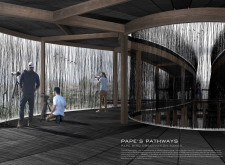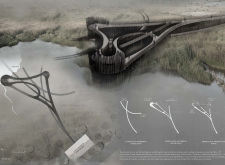5 key facts about this project
### Project Overview
The bird observation tower is situated within Pape Nature Park, a region distinguished by its diverse wetland ecosystems. The design aims to facilitate a structured observation experience for visitors while ensuring minimal disruption to the natural environment. Key objectives include enhancing human interaction with wildlife and promoting environmental awareness through thoughtful architectural strategies and material use.
### Spatial Configuration
The layout comprises an interconnected network of paths and observation platforms at various elevations—lower, middle, and upper.
- **Observation Tower:** This multi-level structure accommodates different group sizes, providing diverse viewing options. It encourages solitary reflection as well as communal experiences in nature observation.
- **Footbridges:** Elevated walkways connect different areas of the park and are designed to minimize environmental impact while offering unique vistas of the surrounding ecosystem.
- **Curvilinear Pathways:** These meandering routes mimic natural topography, fostering organic interactions between visitors and the landscape.
### Material Selection
Material choices are critical for both sustainability and visual integration:
1. **Wood Finishes:** Selected for structural integrity and aesthetic warmth, treated timber ensures durability under wetland conditions.
2. **Natural Fibers:** Materials such as Phragmites australis are utilized for façade elements, enhancing ecological functionality while blending seamlessly with local plant life.
3. **Reinforced Concrete:** This material forms the foundation and structural support, providing stability without imposing on the surroundings.
4. **Glass:** Transparent components minimize visual barriers, allowing unobstructed views of the wetlands, which encourages connection with the habitat.
### Ecological Integration
The project creatively incorporates native and invasive vegetation into its design. By utilizing species like Phragmites, which often present management challenges, the project transforms them into ecological assets. This approach not only showcases architectural innovation but also serves as an educational tool, underscoring the importance of biodiversity and habitat preservation within the community context.
Overall, the project effectively balances functional needs, aesthetic aspirations, and environmental considerations, fostering deeper engagement with the natural environment while promoting continued stewardship and awareness among visitors.





















































